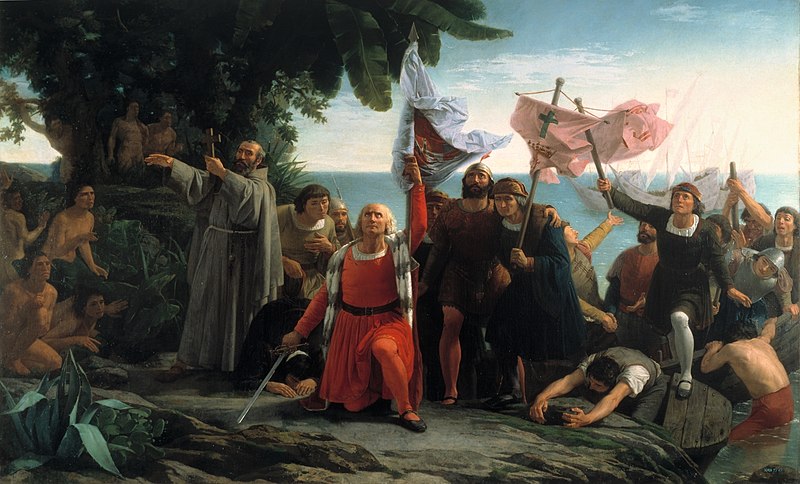| Object history |
La escena representa, según una interpretación muy personal del pintor, la primera expedición a las Indias de Cristóbal Colón (1451/1456?-Valladolid, 1506), y su llegada a Guanahaní el 12 de octubre de 1492, bautizando a esta tierra con el nombre de San Salvador.
En tierra firme un Colón de blanca cabellera, rodilla en tierra, vestido de rojo, con el estandarte enhiesto en su mano izquierda y la espada rendida en la derecha, dirige los ojos hacia el cielo. Le rodean sus compañeros, que van llegando en barcas, representados por personajes vestidos de distinto modo según sean marineros o soldados. Algunos llevan estandartes y otros armas. A la izquierda de la composición un grupo de indígenas semidesnudos y sorprendidos están próximos a un fraile franciscano (un anacronismo ya que no había ninguno en la expedición) que empuña un crucifijo. Al fondo, en un mar en calma, están ancladas las carabelas con las velas plegadas.
El cuadro fue consecuencia del boceto con que cumplió una de sus obligaciones de pensionado de segundo año y que De la Banda dio a conocer. El boceto apenas presenta variantes, salvo el menor empaque de las figuras y leves cambios en algunas de sus actitudes, como los brazos del monje, así como un interesante estudio del natural para la cabeza del almirante.
Además de servir el cuadro de referencia ineludible para cuantos pintores afrontaron después este argumento, el propio Puebla reutilizó el rostro del almirante en una de las figuras de su cuadro Margarita y Mefistófeles en la catedral. Por otra parte, esta pintura quedó inclusa como prototipo compositivo de temas afines, siendo en efecto evocada muy de cerca por Antonio Gisbert en su cuadro Desembarque de los puritanos en la América del Norte, pintado tan solo dos años después. Asimismo, su composición fue recreada por Juan de Orduña en una de las escenas culminantes de su película Alba de América, realizada en 1951 (Texto extractado de: Elorza Guinea, J. C., Dióscoro Puebla (1831-1901), Valladolid: Junta de Castilla y León, Consejería de Cultura y Turismo, 1993, p. 84).
Procedencia: Adquirido al autor, 1863; Museo del Prado, 1863-1896; Museo de Arte Moderno, 1896-1968; Museo Español de Arte Contemporáneo, 1968-1971.
En: The scene represents, according to a very personal interpretation of the painter, the first expedition to the Indies of Christopher Columbus (1451/1456?-Valladolid, 1506), and his arrival in Guanahaní on October 12, 1492, baptizing this land with the name of San Salvador.
On dry land, a white-haired Columbus, kneeling on the ground, dressed in red, with the banner upright in his left hand and the surrendered sword in his right, directs his eyes toward the sky. His companions surround him, arriving in boats, represented by characters dressed differently depending on whether they are sailors or soldiers. Some carry banners and others carry weapons. To the left of the composition, a group of half-naked and surprised indigenous people are close to a Franciscan friar (an anachronism since there was none on the expedition) who is holding a crucifix. In the background, in a calm sea, the caravels are anchored with their sails furled.
The painting was a consequence of the sketch with which he fulfilled one of his obligations as a second-year pensioner and that De la Banda made known. The sketch hardly presents any variants, except for the minor packaging of the figures and slight changes in some of their attitudes, such as the monk's arms, as well as an interesting life study for the admiral's head.
In addition to serving as the unavoidable reference painting for all painters who later faced this argument, Puebla himself reused the admiral's face in one of the figures in his painting Margaret and Mephistopheles in the cathedral. On the other hand, this painting remained even as a compositional prototype of related themes, being in fact evoked very closely by Antonio Gisbert in his painting Landing of the Puritans in North America, painted just two years later. Likewise, its composition was recreated by Juan de Orduña in one of the climactic scenes of his film Alba de América, made in 1951 (Text extracted from: Elorza Guinea, J. C., Dióscoro Puebla (1831-1901), Valladolid: Junta de Castilla y León, Ministry of Culture and Tourism, 1993, p. 84).
Provenance: Acquired from the author, 1863; Prado Museum, 1863-1896; Museum of Modern Art, 1896-1968; Spanish Museum of Contemporary Art, 1968-1971. |








